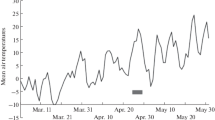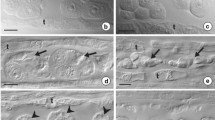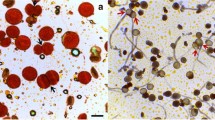Summary
A comparative histological study is made of microsporogenesis in fertile, cytoplasmic male sterile and restored fertilePetunia. Microsporogenesis in sterile anthers proceeds normally until leptotene. The development of the restored fertile type at 25°C is normal until the tetrad stage. In both types sporogenesis arrests and the meiocytes, c.q. microspores ultimately degenerate. The first phenomena of deviation are found in the tapetum. The effects of degeneration on cellular structure, vacuolation and cytoplasmic organization of the tapetal and sporogenous cells are variable. The deposition of callose around the meiocytes appears independent of the process of degeneration. The absence of an increase in callase activity possibly explains the remnants of callose found at late stages of development. The failure of callose wall dissolution appears to be the result of metabolic abnormalities in the tapetum and is regarded as an indirect effect of sterility.
Similar content being viewed by others
References
Bennett MD (1976) The cell in sporogenesis and spore development. In: Yeoman MM (ed) Cell division in higher plants. Academic Press, London New York, pp 161–198
Boeshore ML, Lifshitz I, Hanson RM, Izhar S (1983) Novel composition of mitochondrial genomes inPetunia somatic hybrids derived from cytoplasmic male sterile and fertile plants. Mol Gen Genet 190:459–476
Gupta SC, Nanda K (1978) Onotgeny and histochemistry of dimorphic tapetum inTecoma stans anthers. Soc Bot Fr Actualités Botaniques 125:129–134
Izhar S, Frankel R (1971) Mechanism of male sterility inPetunia: the relationship between pH, callase activity in the anthers, and the breakdown of the microsporogenesis. Theor Appl Genet 41:104–108
Izhar S, Frankel R (1973) Duration of meiosis inPetunia anthers in vivo and in floral bud culture. Acta Bot Neerl 22:14–22
Izhar S, Frankel R (1976) Cytoplasmic male sterility inPetunia. 1. Comparative study of different plasmatype sources. J Hered 67:43–46
Izhar S, Schlicter M, Swartzberg D (1983) Sorting out of cytoplasmic elements through several meiotic cycles. Mol Gen Genet 190:468–474
Kool AJ, de Haas JM, Mol JNM, van Marrewijk GAM (in preparation) Isolation and physicochemical characterization of mitochondrial DNA from cultured cells ofPetunia hybrida
Laser KD, Lersten NR (1972) Anatomy and cytology of microsporogenesis in cytoplasmic male sterile angiosperms. Bot Rev 38:425–454
Leaver CJ, Gray MW (1982) Mitochondrial genome organization and expression in higher plants. Annu Rev Plant Physiol 33:373–402
Lee SLJ, Gracen VE, Earle ED (1979) The cytology of pollen abortion in C-cytoplasmic male sterile corn anthers. Am J Bot 66:656–667
Marrewijk GAM van (1968) Cytoplasmic male sterility and restoring fertility in the garden petunia. Doctorate Thesis, Agricultural University, Wageningen, The Netherlands (in Dutch, with English summary)
Mepham RH, Lane GR (1969) Formation and development of the tapetal periplasmodium inTradescantia bracteata. Protoplasma 68:175–192
Overman MA, Warmke HE (1972) Cytoplasmic male sterility inSorghum. 2. Tapetal behavior in fertile and sterile anthers. J Hered 63:226–234
Vasil IK (1967) Physiology and cytology of anther development. Biol Rev Cambridge Philos Soc 42:327–373
Author information
Authors and Affiliations
Additional information
Communicated by R. Hagemann
Rights and permissions
About this article
Cite this article
Bino, R.J. Histological aspects of microsporogenesis in fertile, cytoplasmic male sterile and restored fertilePetunia hybrida . Theoret. Appl. Genetics 69, 423–428 (1985). https://doi.org/10.1007/BF00570912
Received:
Accepted:
Issue Date:
DOI: https://doi.org/10.1007/BF00570912




